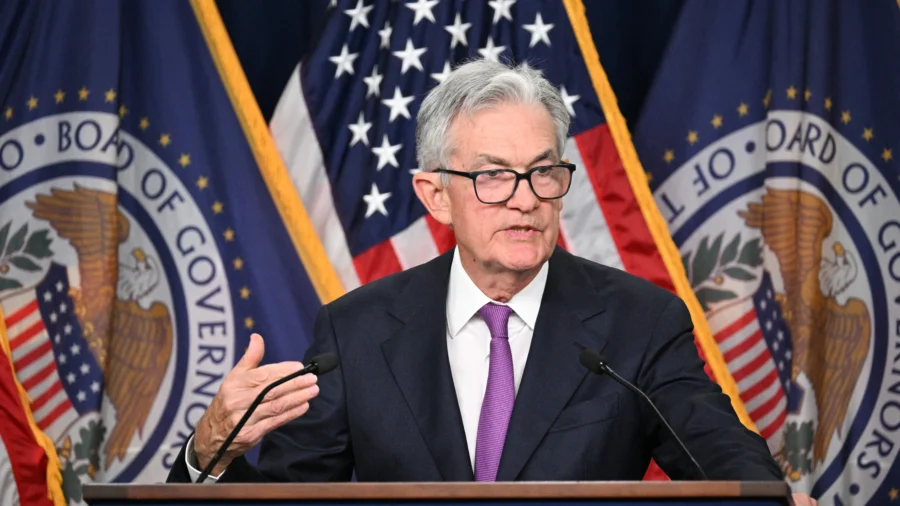The Federal Reserve will hold its final Federal Open Market Committee policy meeting of 2023 this week and policymakers are expected to leave the benchmark interest rate unchanged at a range of 5.25 percent and 5.5 percent. But financial markets might be focusing more on what to expect next year.
Fed officials will publish the updated Summary of Economic Projection (SEP), leaving investors to concentrate on the central bank’s path throughout 2024.
According to the CME FedWatch Tool, the futures market anticipates that the Federal Reserve will not touch interest rates until May 2024. Investors are penciling in a 25- or 50-basis-point rate cut, the first stage of loosening monetary policy conditions since the early days of the COVID-19 pandemic.
After last month’s consumer price index (CPI) report, which came in at 3.2 percent, traders had penciled in a 56 percent chance of a rate cut as early as March 2024. However, after a Goldilocks November jobs report and a higher super core CPI ex-housing report, markets postponed their rate reduction calls by a couple of months.
For the next several months, economists say that the debate will not be about whether the Fed will pull the trigger on one more rate hike. Instead, the discussion will be if the central bank follows through on its “higher-for-longer” mantra or reverses course and starts cutting the Fed funds rate in response to lower inflation and weaker economic growth.
What Experts Are Saying
The Federal Reserve is poised to declare its efforts to restore price stability over, said Judith Raneri, the vice president and senior portfolio manager at Gabelli Funds.
“We expect that the SEP will offer a more encouraging outlook on growth, employment, and inflation, and also include a reduction in the median outlook for interest rates next year, showing a fed funds rate to hit 4.50% down from 5.50% on the upper bound,” said Ms. Raneri in an analyst note. “And given the improved outlook for the economy, Chair [Jerome] Powell will find it difficult not to sound dovish on the future of monetary policy when he addresses reporters after the meeting.”
However, Jay Woods, the chief global strategist at Freedom Capital Markets, thinks the Fed chief will refrain from discussing rate cuts.
“Expect the usual boring narrative to continue. Talking points will remain neutral and his usual claim that the Fed will remain data-dependent and take things one meeting at a time,” Mr. Woods said in a note. “Investors hoping to hear cuts are coming will be disappointed. What they should expect to hear is that the Fed is happy with their progress on fighting inflation and that the path remains clear to achieve their goal.”
Speaking at Spelman College in Atlanta earlier this month, Mr. Powell stated that it would be “premature” to speculate on when to retreat from the institution’s restrictive policy stance.
“Having come so far so quickly, the [Fed] is moving forward carefully, as the risks of under- and over-tightening are becoming more balanced,” the head of the Fed stated in prepared remarks.
Others are ultra-bullish that the Federal Reserve will be aggressive in its easing efforts.
While Mr. Powell and his colleagues are unlikely to endorse the market price of substantial rate cuts heading into the fresh calendar year, ING economists think the evidence supports cuts of 150 basis points in 2024 and another 100 basis points in 2025. With credit demand sliding, real household disposable incomes flatlining, energy prices declining, and pandemic-era savings being exhausted, the bank’s analysts contend that there is likely to be pushback to rate decreases.
“We think the Fed will eventually shift to a more dovish stance, but this may not come until late in the first quarter of 2024,” they wrote in a comprehensive research note. “The US economy continues to perform well for now and the jobs market remains tight, but there is growing evidence that the Federal Reserve’s interest rate increases and the associated tightening of credit conditions are starting to have the desired effect.”
According to the latest CNBC Fed Survey, most economists, analysts, and strategists expect the central bank to start cutting rates in June. The poll also showed that respondents see the odds of a soft landing—growth remains intact, inflation is conquered, and the labor market moderates—at 47 percent. They trimmed the recession probabilities in the next year to 41 percent.
The Recession Debate
Indeed, the Fed’s monthly Beige Book showed that the U.S. economy has softened since the end of summer. The latest data covering the span of Oct. 6 to Nov. 17 revealed that economic conditions and price pressures tapered off. Demand for labor eased, price increases “largely moderated,” and business investment weakened. This could suggest that the central bank’s tightening campaign is beginning to take effect after nearly two years.
“On balance, economic activity slowed since the previous report, with four Districts reporting modest growth, two indicating conditions were flat to slightly down, and six noting slight declines in activity,” the Beige Book stated.
Now, will the country experience anemic growth or face a recession? This is the key question for Douglas Holtz-Eakin, the president of the American Action Forum.

“It seems quite clear at this point that the Fed has substantially reduced demand growth,” he said. “Its continued tightening of financial conditions through shrinking its portfolio will do so further. The only thing that remains unclear is whether the economy will manage to muddle through 2024 with sluggish 0.5 to 1.5 percent growth, or actually experience a modest recession.”
Many recession signals continue to flash red despite the better-than-expected 5.2 percent growth rate in the third quarter.
The Conference Board’s widely monitored Leading Economic Index (LEI) fell 0.8 percent in October, meaning the LEI contracted 3.3 percent between April and October.
“The Conference Board expects elevated inflation, high interest rates, and contracting consumer spending—due to depleting pandemic saving and mandatory student loan repayments—to tip the US economy into a very short recession. We forecast that real GDP will expand by just 0.8 percent in 2024,” said Justyna Zabinska-La Monica, the senior manager of business cycle indicators at The Conference Board.
The Atlanta Fed GDPNow Model estimate suggests that the fourth quarter will post a 1.2 percent expansion. The New York Fed’s Nowcast forecasts a 2.3 percent reading for the October to December period.
All eyes will be on the November retail trade data on Dec. 14, with the consensus estimate showing a 0.1 percent drop. This would represent the second straight monthly decline in retail sales if accurate. Since consumption accounts for two-thirds of the U.S. economy, this is critical data for the country.
From The Epoch Times


